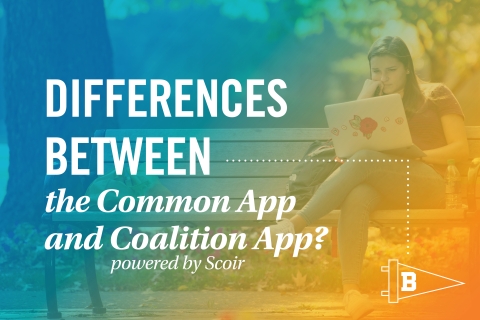The Common Application allows students to apply to multiple colleges with one form. University applications are specific to individual institutions.
Choosing between the Common Application and university-specific applications can impact your college admissions process. The Common Application streamlines the process by letting you submit one application to multiple colleges, saving time and effort. On the other hand, university-specific applications cater to the unique requirements of individual institutions.
Each approach has its own advantages and limitations. Understanding these differences helps you decide the best strategy for your college applications. The choice often depends on the number of colleges you’re applying to and their application preferences. By knowing these distinctions, you can better manage your time and increase your chances of acceptance.

Credit: www.bucknell.edu
Application Process
Understanding the application process is crucial for prospective students. Both the Common Application and University Application have distinct steps. This guide will help you navigate through each process.
Common Application Steps
The Common Application streamlines the process of applying to multiple colleges. Here are the steps:
- Create an account on the Common App website.
- Fill out your personal information.
- Provide academic details, including transcripts.
- Submit standardized test scores.
- Write a personal essay.
- Add your list of colleges.
- Complete college-specific questions.
- Request recommendations from teachers.
- Pay the application fee.
- Submit your application.
University Application Steps
The University Application process varies by institution. Here are the general steps:
- Visit the university’s official website.
- Find the admissions section.
- Create an account or login.
- Fill out your personal and academic information.
- Upload your transcripts and test scores.
- Write any required essays.
- Request letters of recommendation.
- Pay the application fee.
- Submit your application.
Both the Common Application and University Application have their own set of steps. Each process requires attention to detail to complete successfully.
Related Post: What to Do If Your University Application is Rejected: Complete Guidelines
Ease Of Use
Applying to colleges can be daunting. The ease of use of application platforms matters. Let’s explore the user interface and support and resources of the Common Application and University Application.
User Interface
The Common Application has a sleek, intuitive design. Students find it easy to navigate. Its dashboard shows application progress clearly. Users can track deadlines and required documents.
The University Application varies by institution. Some have user-friendly designs, while others are more complex. Students may face different layouts and features for each university.
Support And Resources
The Common Application offers extensive support. Students get access to a help center, FAQs, and video tutorials. Live chat and email support are also available.
With University Applications, support differs by institution. Some universities provide robust help resources, while others may offer limited assistance. Students might need to contact each university for specific support.
| Feature | Common Application | University Application |
|---|---|---|
| User Interface | Sleek and intuitive | Varies by institution |
| Support and Resources | Comprehensive support system | Inconsistent support |
Application Fees
Understanding application fees is crucial in the college application process. Each application type has different costs. This guide will help you navigate these fees.
Common Application Costs
The Common Application is popular among students. It allows you to apply to multiple colleges with one form. The fees for the Common Application vary. Typically, the fee ranges from $25 to $90 per college.
Some colleges offer fee waivers. This helps students who cannot afford the application fees. To apply for a waiver, check if you qualify. The Common Application website provides more details on waivers.
University Application Costs
Each university may have its own application form. These are called University Applications. The costs for University Applications differ. They usually range from $50 to $100.
Many universities also provide fee waivers. These waivers help students with financial need. It’s important to check each university’s website. They have specific instructions on how to apply for a waiver.
| Application Type | Cost Range | Fee Waiver Availability |
|---|---|---|
| Common Application | $25 – $90 | Yes |
| University Application | $50 – $100 | Yes |
Check This: How Much are University Tuition Fees in the UK: 2024 Cost Guide
Customization Options
Choosing between the Common Application and a university-specific application can be tricky. Understanding the customization options available in each can help you decide. Let’s dive into how each application allows for personalization.
Personalization In Common Application
The Common Application offers a one-size-fits-all approach. It lets students apply to multiple colleges with one form. You can customize certain sections to reflect your unique qualities.
- Personal Statement: One essay to showcase your story.
- Activities Section: Highlight up to ten activities.
- Supplemental Questions: Some colleges add their own questions.
The Common Application is great for students applying to multiple schools. It simplifies the process but limits personalization.
Personalization In University Application
A university-specific application allows for deeper customization. Each school creates its own form, tailored to what they value.
- Unique Essays: Different prompts for each university.
- Specific Questions: Focus on what matters to that school.
- Detailed Sections: More room to explain your achievements.
University applications can be more time-consuming. They offer better opportunities to showcase why you fit that school.
Application Deadlines
Understanding application deadlines is crucial for college admissions. Different deadlines apply for the Common Application and individual university applications. These deadlines affect your application strategy and timeline. Knowing them helps avoid last-minute stress.
Common Application Deadlines
The Common Application has a standardized set of deadlines. These deadlines apply to many schools using this platform. Here are the typical deadlines:
| Deadline Type | Date |
|---|---|
| Early Decision | November 1 |
| Early Action | November 1 or 15 |
| Regular Decision | January 1 |
Early Decision is binding. If accepted, you must attend that school. Early Action is not binding. You can apply to other schools. Regular Decision is the final deadline for most schools.
University Application Deadlines
University application deadlines vary by school. Each university sets its own dates. Here are some common deadlines you might encounter:
- Early Decision: Usually around November 1
- Early Action: Typically November 1 or 15
- Regular Decision: Varies, often January 1 or 15
- Rolling Admissions: No specific date, apply anytime
Check each university’s website for exact deadlines. Rolling admissions mean applications are reviewed as they come. Applying early can increase your chances. Early Decision and Early Action deadlines are usually similar to the Common Application deadlines.
Credit: appsupport.commonapp.org
Acceptance Rates
Understanding acceptance rates can help students make informed decisions. There are differences between the Common Application and University-specific applications. Knowing these differences can influence your college application strategy.
Impact On Common Application
The Common Application lets students apply to multiple colleges with one form. This ease of use attracts many applicants. With more applications, acceptance rates often drop. Colleges receive a higher volume of applications but have a limited number of seats. Here is a table showing the impact:
| Year | Number of Applications | Acceptance Rate |
|---|---|---|
| 2020 | 900,000 | 12% |
| 2021 | 1,200,000 | 10% |
Impact On University Application
University-specific applications are tailored to a single institution. Fewer students use these compared to the Common Application. This results in slightly higher acceptance rates for university-specific applications.
Universities know the applicants are interested in their programs. This genuine interest can positively impact acceptance rates. Universities may also have unique criteria that align well with their specific application. Consider these points:
- Less competition for university-specific applications.
- Higher chances if the application aligns with the university’s ethos.
Although the university-specific application process is more focused, it often results in higher acceptance rates.
Pros And Cons
Choosing between the Common Application and a University Application can be confusing. Each has its own benefits and drawbacks. Understanding these will help you make an informed decision.
Advantages Of Common Application
- Convenience: Apply to multiple colleges with one form.
- Time-Saving: No need to fill out many separate applications.
- Consistency: Use the same personal statement for all schools.
Advantages Of University Application
- Customization: Tailor your application to each university’s specific requirements.
- Special Attention: Universities may give more attention to direct applications.
- Additional Information: Provide unique details that may not fit into the Common App.

Credit: www.collegeessayguy.com
Frequently Asked Questions
Is It Better To Apply Through The College Or Common App?
Applying through the Common App saves time by allowing you to apply to multiple colleges at once. Some colleges may have unique application requirements, so check their preferences.
What Is The Difference Between University And Common Application?
A university is an institution offering higher education. The Common Application is a platform to apply to multiple universities with one form.
Is There A Downside To Using A Common App?
Using the Common App can limit your application customization. Some schools may prefer their own application system.
What Is The Difference Between The Common App And The Uc Application?
The Common App is used by many colleges nationwide. The UC application is specific to the University of California system.
Conclusion
Choosing between the Common Application and a university-specific application depends on your needs. The Common App offers convenience and broad reach. University applications may provide a more tailored experience. Both have their unique advantages. Carefully consider your goals and preferences before deciding.
This choice can significantly impact your college application process.
- What is the Difference between Common Application and University Application?
- How Much are University Tuition Fees in the UK: 2024 Cost Guide
- What to Do If Your University Application is Rejected: Complete Guidelines
- Why It is Important in the University Application Process: Key Insights
- Difference between State University And Private University: Key Insights
- When Does University Application Open for 2025: Key Dates Revealed
- Is It Better to Apply Early for University: Unveil the Advantages
- Can You Claim University Application Fees on Taxes Canada: Find Out Now
- How Will University Benefit from Having You on the Course? Discover!
















